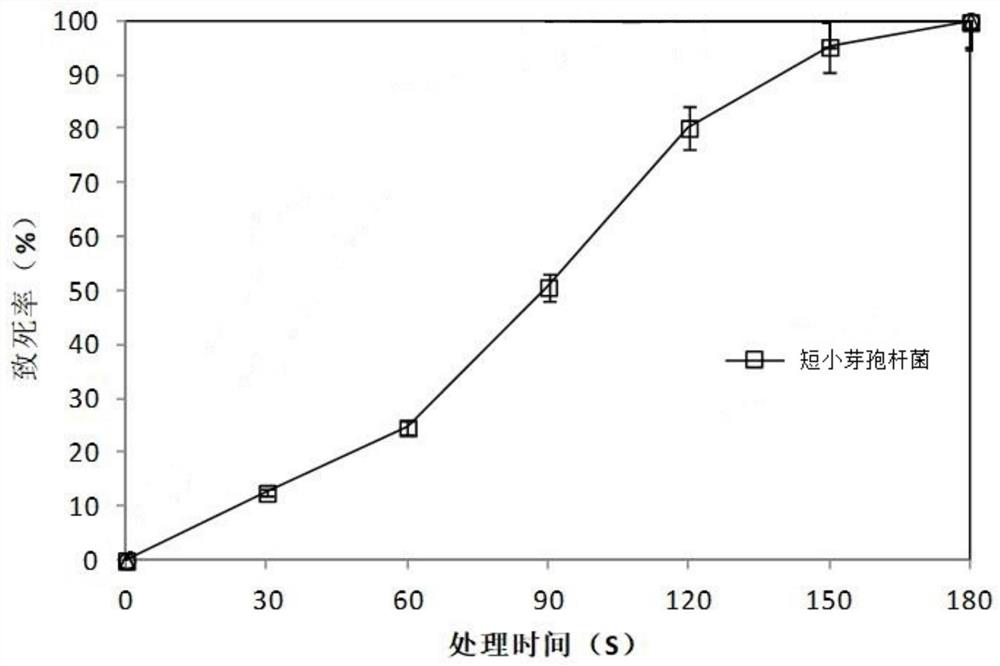Strain of bacillus pumilus BP-09 tolerant to high-concentration tea residues and application of bacillus pumilus BP-09
A technology of Bacillus pumilus, BP-09, applied in the direction of application, bacteria, microbial-based methods, etc.
- Summary
- Abstract
- Description
- Claims
- Application Information
AI Technical Summary
Problems solved by technology
Method used
Image
Examples
Embodiment 1
[0055] The ARTP mutagenesis of embodiment 1 bacterial strain
[0056] 1. Strain activation
[0057] Take the glycerol bacteria of Bacillus pumilus and inoculate them on the slant medium of the bacterial culture medium, and incubate at 30°C for 24 hours. After the culture is over, take a ring of the strain and put it into a fresh slant medium, and incubate at 30°C for 16 hours to further strengthen the vitality of the strain , rejuvenate the strain to achieve the purpose of strain activation.
[0058] 2. Determination of strain ARTP mutagenesis parameters
[0059] Add sterile physiological saline to the slant that has been activated and cultivated, elute, prepare a bacterial suspension, and control the OD of the bacterial suspension 600nm The value is between 0.5-0.7. Take 10 μL of the bacterial suspension and evenly spread it on the surface of the metal slide. After drying, use sterilized forceps to transfer the plate with the sample slide to the ARTP operating chamber. Us...
Embodiment 2
[0064] The domestication screening of embodiment 2 mutant strains
[0065] Take the ARTP-treated bacterial suspension and inoculate it directly into the acclimatization medium, the liquid volume is 50mL of 250mL triangular flask, 30°C, 220rpm, culture for 72h, and investigate the growth of the strain in the medium with tea residue as the main carbon source and reproductive capacity. And by gradually increasing the content of tea residue in the acclimation medium, combined with plate separation, an excellent bacterial strain with strong growth ability, tolerance and utilization of high-concentration tea residue is obtained, preserved, and used for future use. details as follows:
[0066] (1) Domestication of mutant strains by low concentration of tea dregs
[0067] The ARTP-treated bacterial suspension was directly transferred to the acclimation medium for cultivation, and the untreated strain was used as a control to observe the color and odor changes of the fermentation bro...
Embodiment 3
[0077] The identification of embodiment 3 bacillus pumilus BP-09
[0078] 1. Morphological characteristics
[0079] The Bacillus pumilus BP-09 strain was prepared into a bacterial suspension and spread on TSA medium after dilution. After culturing at 30°C for 48 hours, the colonies and cell morphology were observed.
[0080] The results showed that: after being cultured on TSA medium for 48 hours, the colony was round, flat, opaque, light yellow, wrinkled on the surface, and the edges were irregular. Observed under the microscope, the cells were rod-shaped, with blunt rounded ends.
[0081] 2. Physiological and biochemical characteristics
[0082] According to the bacterial identification manual, the physiological and biochemical characteristics of Bacillus pumilus BP-09, such as VP reaction, carbon source utilization, and indole test, were determined.
[0083] The results showed that: the bacterial strain was Gram-positive bacteria, which could not reduce nitrate, the citra...
PUM
 Login to View More
Login to View More Abstract
Description
Claims
Application Information
 Login to View More
Login to View More - R&D
- Intellectual Property
- Life Sciences
- Materials
- Tech Scout
- Unparalleled Data Quality
- Higher Quality Content
- 60% Fewer Hallucinations
Browse by: Latest US Patents, China's latest patents, Technical Efficacy Thesaurus, Application Domain, Technology Topic, Popular Technical Reports.
© 2025 PatSnap. All rights reserved.Legal|Privacy policy|Modern Slavery Act Transparency Statement|Sitemap|About US| Contact US: help@patsnap.com



